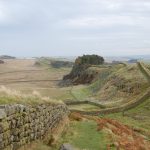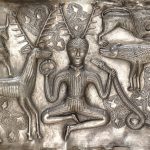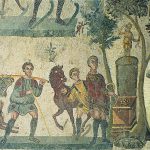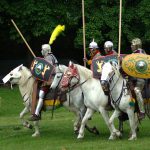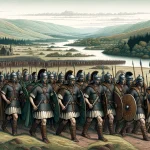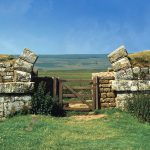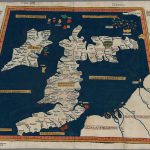Durolevum (Faversham?)
The only classical reference for this minor settlement on Watling Street is the Antonine Itinerary of the late-second century. In the Second Itinerary of this document, entitled “the route from the Vallum [Hadriani] to the port of Rutupiae“, there is a road station named Durolevum listed 13 miles from Durobrivae (Rochester, Kent) and 12 miles from Durovernum (Canterbury, Kent). This corresponds reasonably well with the measured distances from the known Romano-British roadside settlement on the A5 trunk road near the village of Ospringe outside Faversham (also in Kent if you hadn’t guessed).
The Suspected Auxiliary Fort at Judd’s Hill
The area first came under suspect in 1782 after second-century pottery and a first century brooch were discovered during ploughing. When the find-spot of the brooch was examined by the eminent historian Hasted in the same year, he recovered more second-century pottery and a coin of Vespasian and also reported a ‘square’ enclosure with rounded corners typical of Roman construction lying wholly on the south side of the road on Judd’s Hill. The enclosure was said by Hasted to be ‘defined by the remains of a very deep and broad ditch, which enclosed an area of between 3 and 4 acres’ (1.2 to 1.6 hectares). The same site was examined by Bedo in 1874 who estimated that the enclosure measured 400 feet east-west by 480 feet north-south (121.9 x 146.3 metres). The 1967 OS map of the area records only the north-west corner angle and a short stretch of the western side, so it would appear that continued ploughing has now removed almost all evidence of this possible Roman military enclosure which now lies in the grounds of the Syndale Park Motel.
It is quite likely, judging from its attested past outline and surviving rounded corner-angle, that the Judd’s Hill enclosure represents a Roman military encampment. The fact that its outline could still be viewed in heavily cultivated country in the eighteenth century suggests these were not the remains of a mere temporary marching camp, and it is quite possible that the site represents an early (i.e. perhaps Claudian) fort. The heavy agricultural activity on the site is not all bad news, however, for a number of Roman coins, mostly dated to the Hadrianic period, were uncovered within the perimeter of the enclosure during ploughing in the 1960’s. Unfortunately, these cannot be positively connected with any activity at the suspected fort.
Given the measurements of Bedo taken in the nineteenth century, the internal area of the camp would be a little under 4½ acres (c.1.8 ha). This is more than enough space to house a five-hundred strong auxiliary infantry regiment,¹ perhaps even a mixed regiment of infantry and cavalry,² at a pinch.
- A cohors quingenaria peditata was composed of six infantry centuriae each comprised of eighty milites totalling 480 ordinary soldiers. There were in addition around twenty officers including the military tribune in command.
- A cohors equitata was a mixed regiment of four infantry centuriae and four cavalry turmae (4*80 foot & 4*32 horse = 448 men), again complimented with around 20 officers. The extra space was that required for the 130+ horses.
There are no inscriptions on stone recorded in the R.I.B. for Ospringe.
The Settlement of Durolevum
The location of the Roman settlement in the small valley between Beacon Hill and Judd’s Hill was confirmed during the cutting of a gas-pipe trench to the north of the road in 1931. Roman occupation debris was found within a 200 metre stretch, including storage pits, hearths, animal bones, oyster shells, walls made of flint and of chalk blocks, also pottery dateable to the second and third centuries. A trial trench dug for a distance of 400 feet (123 metres) along the south side of the road in 1967 uncovered stratified layers of Roman occupation material along all of its length. Pottery remains were again dated to the second and third centuries. The recorded finds were mostly confined within a narrow stretch to either side of the Watling Street in the valley bottom, but the settlement is thought to have extended eastwards to the top of Judd’s Hill where the military enclosure is suspected.
It is possible that the Imperial Posting Station itself was actually located a little way along the Watling Street to the west of the settlement, and remains yet to be discovered. This would explain the slight discrepancy between the measured distances and those recorded in Antonine Iter II.
Probable Romano-British Temple
The remains of a substantial Roman building was discovered in 1969 to the north-west of the Ospringe settlement about (90 m) north of the road (at TQ9961), where the remains had been incorporated within the structure of a later church. When excavated, the original Roman structure was found to measure 20 by 19 feet (6.1 x 5.8 metres) with butressed walls, an opus signinum floor, plaster mouldings and painted wall frescoes. The excavators suggested that the building served as either a mausoleum or in some sort of ceremonial or religious capacity; the fact that a Christian church was later built on the site lends credence to this view. The sparse dating evidence suggests a period of use sometime during the 4th century.
The Roman Cemetery
Two separate Roman burial sites (or one long cemetery) have been discovered about ¼mile and ½mile to the east of the hilltop enclosure close to the site of the local Museum. Excavations conducted during the 1920’s uncovered three-hundred and eighty-seven burials, both cremations and inhumations, mainly dated to the second and third centuries although some of the inhumations were thought to date to the fourth.
Other Roman Sites in the Neighbourhood
There are records of another substantial Roman building nearby at Luddenham (TQ9862), a villa a little to the east at Faversham (TR0261), and an iron-mine at Brenley Corner (TR0459) a couple of miles further east along Watling Street.
References for Durolevum – [meaning unknown]
Roadside Settlements in Lowland Roman Britain by Roger Finch Smith (BAR#157, 1987, pp.132-4, & fig.4).
Sites near Durolevum (Faversham?)
- Ospringe (Durolevum?) (0 km)
Minor Settlement - Isle Of Sheppey (11 km)
- Bigbury Camp (13 km)
Iron Age Hillfort - Canterbury (Durovernum) Roman Fort (16 km)
British Capital, Claudian Auxiliary Fort (AD 43–54) and Oppidum - Canterbury Roman Museum (16 km)
Museum - Maidstone (24 km)
Villa - Reculver (Regulbium) Fort (25 km)
Saxon Shore Fort - Rochester (Durobrivae) (26 km)
Minor Settlement - Pilgrims' Way (26 km)
Roman Road - Eccles Claudian Villa (27 km)
Barrow, Roman-Building, Temple Or Shrine and Villa
